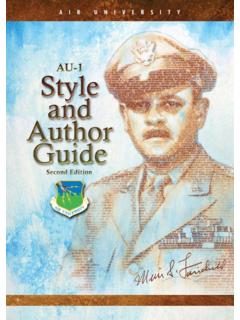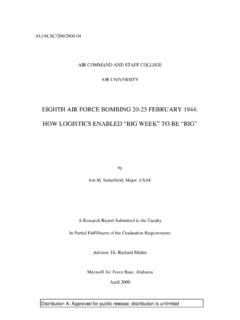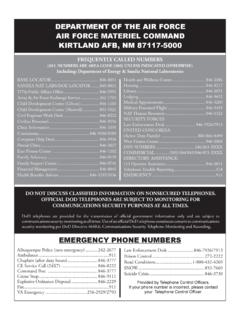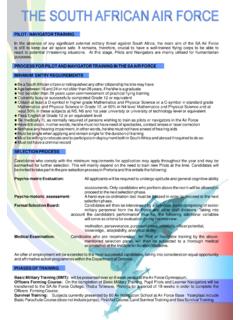Transcription of AIR FORCE INSTITUTE OF TECHNOLOGY
1 I'-v,-;. r:% ** 4" - '" - ..-.;^/".'. s mm :\ '''" * ;-"i PUS SL; ^:f^Wvv*AU^ : ** v y> < iPf" ' S& PI MILITARY AIR CARGO CONTAINERIZATION GRADUATE RESEARCH PAPER Joseph W. Mancy, Major, USAF AFIT/GMO/LAL/96J-4 : ." " '* - ' DEPARTMENT OF THE AIR FORCE AIR UNIVERSITY 1 J AIR FORCE INSTITUTE OF TECHNOLOGY Wright-Patterson Air FORCE Base, Ohio DISTRIBUTION STATk'jMfctff Jfc Approved to public release; Distribution UnHmlted ? DTIC QUALITY INSPECTED 1 AFIT/GMO/LAL/96J-4 MILITARY AIR CARGO CONTAINERIZATION GRADUATE RESEARCH PAPER Joseph W. Mancy, Major, USAF AFIT/GMO/LAL/96J-4 19960617 134 Approved for public release; distribution unlimited The views expressed in this graduate research paper are those of the author and do not reflect the official policy or position of the Department of Defense or the Government. AFIT/GMO/LAL/96J-4 MILITARY AIR CARGO CONTAINERIZATION GRADUATE RESEARCH PAPER Presented to the Faculty of the Graduate School of Logistics and Acquisition Management of the Air FORCE INSTITUTE of TECHNOLOGY Air University in Partial Fulfillment of the Requirements for the Degree of Master of Art in Mobility Joseph W.
2 Mancy, , Major, USAF May 1996 Approved for public release; distribution unlimited Acknowledgments The Advanced Studies in Air Mobility program would not have been possible without the vision, dedication, and support of the Air Mobility Warfare Center staff and Air FORCE INSTITUTE of TECHNOLOGY faculty. This was a bold new program requiring interim revisions and innovative solutions. Despite the obstacles, the staff and faculty embraced this new program with a determined zeal to see the students and program succeed. They attained their goal by sending ten students forward with the best possible education and the shared memories of a common journey to last a lifetime. I would like to thank my advisor, Dr. William Cunningham, and Dr. David K. Vaughan for their support and guidance on this paper. Finally, my wife Veronica is, and will continue to be, a pillar of support. She has yet to receive a medal, ribbon, or citation for her sacrifice.
3 She prefers to stand quietly behind me with a smile and encouragement knowing her medal is in my heart. Joseph W. Mancy Table of Contents Page Acknowledgments ii List of Figures v Abstract vi I. Introduction 1 General Issue 1 Importance of Research 4 Problem Statement 6 Research Objectives 6 Research Questions 7 Graduate Research Paper Overview 7 II. Literature Review 8 Introduction 8 Intermodalism 8 Containerization 11 Air Containerization 13 Military Air Containerization 15 III. Discussion Analysis 18 Introduction 18 Benefits 18 Reduced Damage 19 Reduced Pilferage 19 Reduced Handling 20 Efficient Use of Space 22 Cargo Tracking 23 Truck-Rail Transshipment Compatibility 24 Specialized Cargo 24 Preclearance and Preweighing 24 Reduced Documentation 25 Faster Cargo Movement ..26 Customer Service 26 in Page Feasibility 27 Availability 28 Compatibility 28 Transportability 30 Interoperability 30 Reliability 31 Wartime Usage Rates 31 Ability to Manufacture 31 Safety 32 Human Factors 32 Supportability 32 Logistics 32 Training 33 Constraints 34 Container Tare Weight 34 Interoperability 35 Backhaul 35 Expense 36 Damage 36 Cargo Fit 36 IV.
4 Recommendations and Conclusion 38 Overview 38 Review of Questions 38 Future Plans 39 Research 40 Modeling 40 Testing 40 Implementation 41 Conclusion 41 Bibliography 43 Vita 46 IV List of Figures Figure Page 1. CONEX Container 2 2. Modular Container (MODCON) 3 3. Overview of Containerization 8 4. 463 L Pallet 19 5. Air Cargo Flow with Pallets and Containers 21 6. Refrigerated Container 25 7. ISU-90 Intermodal Container 29 8. ISU-70 Intermodal Container 29 AFIT/GMO/LAL/96J-4 Abstract The transportation industry has seen the proven benefits of cargo containerization in other modes of transportation. The civilian air sector has gone to containerization. Unlike the civilian counterparts, the Air FORCE did not make the transition to containers, even though containers have proven themselves to be more economical and efficient in both the surface transportation and civilian air cargo transportation industries. Limited military studies validate the improved efficiency of air cargo containerization, but obstacles remain.
5 This study addresses the possible use of air intermodal containers to replace the current 463L pallet system. The air intermodal container is examined based on the benefits, feasibility, and constraints associated with its use. The Department of Defense must continue to examine the transportation process. Implementing an air cargo containerization program without investigating collateral effects on other transportation systems may suboptimize the overall system. VI MILITARY AIR CARGO CONTAINERIZATION I. Introduction General Issue The surface transportation industry has made great strides in the advancement of intermodalism to survive within a transportation environment. Containerization is a precursor to effective intermodal transportation. "The great enabler of this boom is the container the ubiquitous steel box that permits increasing amounts of global cargo without having to be unpacked en route" (Miles, 1995: 24). Gerhardt Muller defines containerization as general or specialized cargo placed in a container resulting in efficient and economical shipment through various modes (M ller, 1989: 204).
6 Containerization improves the efficiency of interchange among various transportation modes and reduces the potential for damage and theft due to reduced intransit handling (Coyle and others, 1994: 264). Advances in multimodal containers allow shippers to easily transfer cargo from train to ship to truck or to aircraft without breaking down the cargo, storing it, and rebuilding it. Containerization offers shippers flexibility, cargo protection, better in-transit visibility, and cost savings. Military air intermodal containerization has yet to progress as it has in the surface transportation industry or as it has in civilian air cargo transportation. To realize the benefits and efficiencies of intermodalism in military airlift, the Air FORCE must develop and use standardized intermodal containers. One of the first military uses of air cargo intermodal containerization came during the Vietnam War. The Army CONEX system was developed in the late 1950s and fielded in the 1960s.
7 It offered an improved method of carrying and sheltering parts. The Air FORCE and Army used nearly 150,000 CONEX containers during the Vietnam War (Berg, 1992: 36). Today, many CONEX containers are used as storage shelters (see Figure 1). Figure 1. CONEX Container (Weingarten, 1972: 5). One demonstration between surface and air intermodal capability using existing 20-foot International Standards Organization (ISO) containers was "Project INTACT" (Intermodal Air Cargo Test), conducted in 1975. This test was a combined effort involving the United States Air FORCE , the Department of Transportation, Lockheed- Georgia, and the shipping industry. A C-5 Galaxy transport loaded with 20-foot ISO Containers flew from Oakland, California, to Nashville, Tennessee. The test results demonstrated the inherent efficiencies of moving cargo using containers, and proved intermodal heavy cargo airlift was economically feasible. The test also concluded that even greater efficiencies would result with a greater distance traveled (Cavin, 1993: 16).
8 A prototype intermodal modular container (MODCON) was developed and tested in 1973. The MODCON is a true intermodal container compatible with current Air FORCE airlift aircraft and material handling equipment. The dimensions of the MODCON are 48"H x 48"W x 40"L. The MODCON can be combined and attached in various configurations to yield an assortment of different dimensions including the standard commercial 8'W x 8'H x 20'L container (20-foot ISO container) as shown in Figure 2. These containers can be separated and disassembled for storage and shipping. Figure 2. Modular Container (MODCON) (Kelley, 1974: 3). MODCON test findings concluded that the modules were easily damaged, lacked rigidity, and possessed a tare weight as high as 50 percent of the total weight shipped. The test also concluded that continued use beyond the initial testing would cause deterioration of the 463L material handling equipment (MHE) and aircraft roller systems.
9 Based on the test results, the Department of Defense did not support the development and implementation of the MODCON (Kelley, 1974: 2-10). In 1995, the US Army completed a Joint Container Exercise Program, in which a Fort Lewis Signal Battalion's equipment was containerized and shipped to Korea. The results of this exercise demonstrated the tremendous increase in efficiency containerization offers the Department of Defense. To date, there is no known exercise or plan to test the feasibility of containerization for air cargo deployments. Importance of Research General Fogleman, USAF Chief of Staff, stated, "General Erwin Rommel said that the first condition for armies to endure the strain of battle is to have ample stocks of weapons, ammunition, and fuel. Battles are decided by quartermasters, for even brave soldiers can do nothing without weapons" (Fogleman, 1994, 75). The Department of Defense would gain great efficiencies in cargo movement by revising the transportation structure from source to final user.
10 When viewing the overall logistical pipeline, the rapid movement of air cargo can provide savings over the cost of keeping a large inventory. Aside from inventory savings, containerization has other benefits. Dr. M. A. Khan, Professor of Marketing at James Madison University, says containerization offers eight advantages over conventional air freight: 1. door-to-door service 2. truck chassis compatibility and transport operator familiarity 3. container compatibility with handling equipment and procedures 4. container adaptability to demands of cargo 5. lower cross-handling costs 6. improved security provided by locked container 7. customs clearance in advance of international travel 8. simplified cargo rate structure (Khan and Neuhauer, 1979: 13) In addition to the source-to-user concept, air cargo containerization offers the military higher input-output efficiency, quicker aircraft turnaround, and more efficient aircraft use.

















